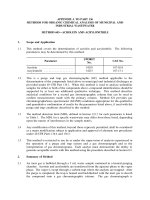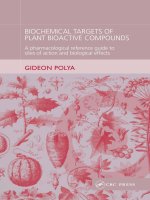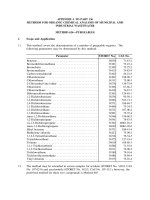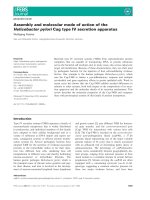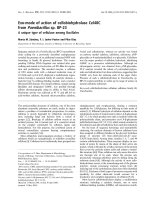stenersen - chemical pesticides - mode of action and toxicology (crc, 2004)
Bạn đang xem bản rút gọn của tài liệu. Xem và tải ngay bản đầy đủ của tài liệu tại đây (1.67 MB, 296 trang )
C
HEMICAL PESTICIDE
S
M
ODE OF ACTION AND TOXICOLOG
Y
CRC PRESS
Boca Raton London New York Washington, D.C.
Jørgen Stenersen
C
HEMICAL PESTICIDE
S
M
ODE OF ACTION AND TOXICOLOG
Y
This book contains information obtained from authentic and highly regarded sources. Reprinted material
is quoted with permission, and sources are indicated. A wide variety of references are listed. Reasonable
efforts have been made to publish reliable data and information, but the author and the publisher cannot
assume responsibility for the validity of all materials or for the consequences of their use.
Neither this book nor any part may be reproduced or transmitted in any form or by any means, electronic
or mechanical, including photocopying, microfilming, and recording, or by any information storage or
retrieval system, without prior permission in writing from the publisher.
The consent of CRC Press LLC does not extend to copying for general distribution, for promotion, for
creating new works, or for resale. Specific permission must be obtained in writing from CRC Press LLC
for such copying.
Direct all inquiries to CRC Press LLC, 2000 N.W. Corporate Blvd., Boca Raton, Florida 33431.
Trademark Notice:
Product or corporate names may be trademarks or registered trademarks, and are
used only for identification and explanation, without intent to infringe.
Visit the CRC Press Web site at www.crcpress.com
©2004 by Jørgen Stenersen
No claim to original U.S. Government works
International Standard Book Number 0-748-40910-6
Library of Congress Card Number 2004043568
Printed in the United States of America 1 2 3 4 5 6 7 8 9 0
Printed on acid-free paper
Library of Congress Cataloging-in-Publication Data
Stenersen, Jørgen.
Chemical pesticides: mode of action and toxicology / Jørgen Stenersen.
p. cm.
Includes bibliographical references and index.
ISBN 0-7484-0910-6
1. Pesticides Toxicology. I. Title.
RA1270.P4S74 2004
615.9'02 dc22
2004043568
Dedication
To Eira, my grandchild
Without your inspiration, references from 2002 and 2003 would have
been missing and the book already outdated! Although much wisdom
can be extracted from Tomlin’s
The Pesticide Manual,
even more is
found in
The Norwegian Folk Tales
and Astrid Lindgren’s
Pippi
Langstrømpe,
which you for long periods gave me an excuse to
concentrate upon.
About the Author
Jørgen H.V. Stenersen, Dr. Philos.
, is a professor in ecotoxicology at the
Biological Institute, University of Oslo. He graduated as Cand. Real. in
biochemistry in 1964 (University of Oslo) and subsequently worked at the
Norwegian Plant Protection Institute on research related to possible side
effects of pesticides. His first interests were the mechanisms behind insect
resistance to insecticides, with emphasis on DDT resistance in stable flies.
He was also engaged in studies of the extent of DDT contamination of soil,
fauna, and humans as a result of DDT usage in orchards.
During a one-year stay at the Agricultural Research Laboratory in Lon-
don, Ontario, Canada, he became interested in the effects of pesticides on
earthworms at the biochemical level. This became his research focus for some
years. A stay at the Biochemical Institute of the University of Stockholm led
to research in the comparative biochemistry of biotransformation enzymes
(glutathione transferases).
In 1985, Dr. Stenersen was a senior lecturer in ecotoxicology at the
University of Oslo, becoming a professor in 1994. Since then he has been
devoted to the education of environmental toxicologists. It is his opinion
that the basic knowledge of health-oriented toxicologists and ecotoxicolo-
gists should be the same, or at least overlap so they can compete in the same
job market and “speak the same language.” He is a member of the Norwe-
gian Committee for Approval of EUROTOX Registered Toxicologists and is
responsible for the master’s and Ph.D. studies of toxicology at the Biological
Institute, University of Oslo.
The mode of action of pesticides, development of resistance, and their
side effects are central topics in this pursuit. The present book is an enlarged
revision of an earlier book written in Norwegian (
Kjemiske plantevernmidler
,
1988, Yrkeslitteratur as, Oslo, pp. 218), and is suited to introductory courses
in general toxicology. Dr. Stenersen’s current research interest is the appli-
cation of biochemical methods in terrestrial ecotoxicology.
Acknowledgments
I thank in particular Professor John Ormerod at the Department of Biology,
University of Oslo; Senior Scientist Avi Ring at the Norwegian Defense
Research Institute; and Senior Scientist Christian Thorstensen at the Norwe-
gian Plant Protection Institute for reviewing the many chapters, correcting,
and proposing rewriting. Thanks also go to Baard Johannessen for providing
materials to the chapter about interaction. I also thank my students that had
to hear and learn more about pesticides than they actually needed for their
exams and future jobs.
I also thank Catherine Russel at Taylor & Francis for her difficult job of
correcting my English.
Contents
Chapter 1 Introduction 1
1.1 Motivation 1
1.2 Pesticides and opinion 2
1.2.1 The fly in the soup 2
1.2.2 Low-tech food production 3
1.2.3 Conclusion 3
1.3 A great market 4
1.3.1 The number of chemicals used as pesticides 4
1.3.2 Amounts of pesticides produced 4
1.3.3 Marketing 6
1.3.4 Dirty dozens 7
1.4 Nomenclature, definitions, and terminology 9
1.4.1 Toxicology, ecotoxicology, and environmental toxicology 9
1.4.2 Pesticides, biocides, common names, chemical names,
and trade names 10
1.4.3 Chemical structures are versatile 12
Helpful reading 13
Biochemistry and cell biology 13
General toxicology 13
Insect biochemistry, plant physiology, and neurophysiology 13
Pesticides 14
Side effects of pesticides 14
Chapter 2 Why is a toxicant poisonous? 15
2.1 Seven routes to death 15
2.1.1 Enzyme inhibitors 16
2.1.2 Disturbance of the chemical signal systems 16
2.1.3 Toxicants that generate very reactive molecules that
destroy cellular components 17
2.1.4 Weak organic bases or acids that degrade the pH
gradients across membranes 17
2.1.5 Toxicants that dissolve in lipophilic membranes and
disturb their physical structure 18
2.1.6 Toxicants that disturb the electrolytic or osmotic balance
or the pH 18
2.1.7 Strong electrophiles, alkalis, acids, oxidants, or reductants
that destroy tissue, DNA, or proteins 18
2.2 How to measure toxicity 18
2.2.1 Endpoints 18
2.2.1.1 Endpoints in ecotoxicology and pest control 19
2.2.1.2 Endpoints in human toxicology 19
2.2.2 Dose and effect 20
2.2.3 Dose and response 21
2.2.3.1 Dose–response curves for the stable fly 24
2.2.3.2 Scatter in dose–response data 25
2.2.4 LD50 and related parameters 26
2.2.5 Acute and chronic toxicity 27
2.3 Interactions 27
2.3.1 Definitions 28
2.3.2 Isoboles 29
2.3.3 Mechanisms of interactions 30
2.3.4 Examples 30
2.3.4.1 Piperonyl butoxide 30
2.3.4.2 Deltamethrin and fenitrothion 32
2.3.4.3 Atrazine and organophosphate insecticides 32
Chapter 3 Pesticides interfering with processes important to all
organisms 35
3.1 Pesticides that disturb energy production 35
3.1.1 Anabolic and catabolic processes 35
3.1.2 Synthesis of acetyl coenzyme A and the toxic mechanism
of arsenic 36
3.1.3 The citric acid cycle and its inhibitors 36
3.1.3.1 Fluoroacetate 36
3.1.3.2 Inhibitors of succinic dehydrogenase 37
3.1.4 The electron transport chain and production of ATP 38
3.1.4.1 Rotenone 38
3.1.4.2 Inhibitors of electron transfer from cytochrome
b to c
1
40
3.1.4.3 Inhibitors of cytochrome oxidase 41
3.1.4.4 Uncouplers 41
3.1.5 Inhibition of ATP production 42
3.1.5.1 Organotin compounds 43
3.1.5.2 Diafenthiuron 44
3.1.5.3 Summary 45
3.2 Herbicides that inhibit photosynthesis 45
3.2.1 Weak organic acids 49
3.2.2 Free radical generators 49
3.2.3 D
1
blockers 51
3.2.3.1 Urea derivatives 51
3.2.3.2 Triazines 52
3.2.4 Inhibitors of carotene synthesis 53
3.2.4.1 Amitrole 53
3.2.4.2 Aclonifen 53
3.2.4.3 Beflubutamid 53
3.2.5 Protoporphyrinogen oxidase inhibitors 54
3.3 General SH reagents and free radical generators 54
3.3.1 Mercury 54
3.3.2 Other multisite fungicides 56
3.3.2.1 Perhalogenmercaptans 56
3.3.2.2 Alkylenebis(dithiocarbamate)s and
dimethyldithiocarbamates 57
3.3.2.3 Fungicides with copper 58
3.4 Pesticides interfering with cell division 59
3.4.1 Fungicides 61
3.4.1.1 Benomyl 61
3.4.1.2 Thiofanate-methyl 61
3.4.1.3 Carbendazim 62
3.4.1.4 Thiabendazole 62
3.4.1.5 Diethofencarb 62
3.4.2 Herbicides 62
3.4.2.1 Trifluralin 62
3.4.2.2 Carbetamide 63
3.5 Pesticides inhibiting enzymes in nucleic acid synthesis 63
3.5.1 Sporulation-inhibiting fungicides 63
3.5.2 Inhibition of incorporation of uridine into RNA 64
Chapter 4
Bacillus thuringiensis
and its toxins 67
4.1 The mechanism of action of
δ
-endotoxins 68
4.2 Biotechnology 70
4.3 Engineered plants 70
4.4 Biology 70
4.5 Commercial products 71
Chapter 5 Specific enzyme inhibitors 73
5.1 Inhibitors of ergosterol synthesis 73
5.1.1 Inhibition of HMG-CoA reductase 74
5.1.2 Inhibition of squalene epoxidase 75
5.1.3 DMI fungicides 76
5.1.4 Examples of DMI fungicides from each group 78
5.1.4.1 Azoles and triazoles 78
5.1.4.2 Pyridines and pyrimidines 78
5.1.4.3 Piperazines 79
5.1.4.4 Amines 79
5.1.4.5 Morpholines 80
5.1.5 Conclusions 81
5.2 Herbicides that inhibit synthesis of amino acids 81
5.2.1 The mode of action of glyphosate 81
5.2.2 Degradation of glyphosate 83
5.2.3 Selectivity 84
5.2.4 Mode of action of glufosinate 84
5.2.5 Inhibitors of acetolactate synthase 86
5.3 Inhibitors of chitin synthesis 88
5.3.1 Insecticides 88
5.3.2 Fungicides 90
5.4 Inhibitors of cholinesterase 90
5.4.1 Acetylcholinesterase 90
5.4.2 Organophosphates 95
5.4.2.1 Naturally occurring organophosphorus
insecticides 97
5.4.3 Carbamates 97
5.4.3.1 Molecular structure and potency of inhibition 98
5.4.4 Development of organophosphorus and carbamate
insecticides 99
5.4.4.1 Parathion and similar compounds 103
5.4.4.2 Aliphatic organophosphates 107
5.4.4.3 Examples of carbamates 107
5.5 Other enzymes inhibited by organophosphates and carbamates 109
5.5.1 The butyrylcholinesterases 109
5.5.2 The neurotoxic target enzyme (NTE) 110
5.5.3 Carboxylesterases 113
Chapter 6 Interference with signal transduction in the nerves 115
6.1 Potency of nerve poisons 115
6.2 Selectivity 115
6.3 The nerve and the nerve cell 116
6.4 Pesticides that act on the axon 117
6.4.1 Impulse transmission along the axon 117
6.4.2 Pesticides 119
6.4.3 Pyrethroids 119
6.4.4 DDT and its analogues 124
6.5 Pesticides acting on synaptic transmission 125
6.5.1 Inhibitory synapses 126
6.5.2 Pesticides 127
6.5.2.1 Lindane 127
6.5.2.2 Fipronil 130
6.5.2.3 Cyclodiene insecticides 130
6.5.2.4 Avermectins 130
6.5.3 The cholinergic synapses 131
6.5.3.1 Atropine 133
6.5.3.2 Nicotinoids and neonicotinoids 134
6.5.3.3 Cartap 136
6.5.4 Calcium channels as possible targets for insecticides 136
6.6 Summary 137
Chapter 7 Pesticides that act as signal molecules 139
7.1 Insect hormones 139
7.1.1 Insect endocrinology 139
7.1.2 Juvenile hormone 140
7.1.2.1 American paper towels 141
7.1.2.2 Juvenile hormone agonists as pesticides 141
7.1.2.3 Antagonists 143
7.1.3 Ecdysone 143
7.1.3.1 Phyto-ecdysones 144
7.1.3.2 Synthetic ecdysteroids used as insecticides 145
7.1.3.3 Azadirachtin 145
7.2 Behavior-modifying pesticides 146
7.2.1 Definitions 147
7.2.2 Pheromones 148
7.2.3 Structure–activity relationships 148
7.2.3.1 Alarm and trail pheromones 149
7.2.3.2 Aggregation pheromones 149
7.2.4 Pheromones used as pesticides and lures 151
7.2.4.1 Coleoptera 151
7.2.4.2 Lepidoptera 152
7.2.4.3 Fruit flies 153
7.2.4.4 Aphid food deterrent 154
7.2.4.5 Mosquito repellents 154
7.5 Plant hormones 155
Chapter 8 Translocation and degradation of pesticides 161
8.1 The compartment model 161
8.1.1 The bioconcentration factor 164
8.1.2 The half-life 164
8.1.3 The area under the curve 165
8.1.4 Example 165
8.1.4.1 Disappearance of dieldrin in sheep 165
8.1.4.2 Dieldrin uptake in sheep 166
8.2 Degradation of pesticides by microorganisms 166
8.2.1 Degradation by adaption 166
8.2.2 Degradation by co-metabolism 167
8.2.3 Kinetics of degradation 167
8.2.4 Importance of chemical structure for degradation 168
8.2.5 Examples 169
8.2.5.1 Co-metabolism and adaptation 169
8.2.5.2 Parathion and other pesticides with nitro groups 171
8.2.5.3 Ester hydrolysis of carbaryl 171
8.2.5.4 Mineralization of dalapon 172
8.2.6 The degraders 172
8.3 Soil adsorption 173
8.3.1 Why are chemicals adsorbed? 173
8.3.2 Examples 173
8.3.2.1 Measurements of adsorption 175
8.3.3 Desorption 177
8.4 Evaporation 178
8.4.1 Example 179
8.5 Biotransformation in animals 180
8.5.1 Oxidation 181
8.5.2 Epoxide hydrolase 184
8.5.3 Glutathione transferase 185
8.5.4 Hydrolases 187
8.5.5 Glucoronosyltransferase and sulfotransferase 187
8.5.6 Stereospecific biotransformation 188
8.6 Designing pesticides that have low mammalian toxicity 189
8.6.1 Acephate 190
8.6.2 Malathion and dimethoate 191
8.6.3 Nereistoxin 192
Chapter 9 Resistance to pesticides 193
9.1 Definitions 193
9.2 Resistance is an inevitable result of evolution 194
9.2.1 Time for resistance development 194
9.2.2 Questions about resistance 196
9.2.2.1 Are resistant insects more robust than
sensitive ones? 196
9.2.2.2 Is resistance caused by one allele in one
gene locus? 196
9.2.2.3 Do pesticides cause resistance? 197
9.3 Biochemical mechanisms 197
9.3.1 Increased detoxication 199
9.3.1.1 DDT dehydrochlorinase 199
9.3.1.2 Hydrolases 200
9.3.1.3 CYP enzymes in insects 200
9.3.1.4 CYP enzymes in plants 201
9.3.2 Insensitive target enzyme or target receptor site 201
9.3.2.1 Acetylcholinesterase 201
9.3.2.2 kdr resistance 202
9.3.3 Resistance in fungi 203
9.3.3.1 Benzimidazole 203
9.3.3.2 Sterol biosynthesis inhibitors 204
9.3.4 Atrazine resistance and plants made resistant
by genetic engineering 204
9.3.5 Resistance to glyphosate 205
9.3.5.1 Summary 207
9.3.6 Resistance to older biocides used as pesticides 207
9.3.7 Resistance to third- and fourth-generation pesticides 208
9.4 How to delay development of resistance 208
9.4.1 Refuge strategy 209
9.4.2 Mixing pesticides with different modes of action and
different detoxication patterns 210
9.4.3 Switching life-stage target 210
9.4.4 Increased sensitivity in resistant pests 210
9.4.5 Inhibition of detoxication enzymes 210
9.5 Conclusions 211
Chapter 10 Pesticides as environmental hazards 213
10.1 Pesticides are poisons 213
10.1.1 Pesticides are xenobiotics 215
10.1.2 Various types of bias 217
10.1.2.1 Publication bias 217
10.1.2.2 Test bias 218
10.1.2.3 Extrapolation bias 219
10.1.3 Benchmark values 220
10.2 Required toxicological tests for official approval
of a pesticide 220
10.3 Analysis of residues in food and the environment 222
10.3.1 Definitions 222
10.3.2 Sampling 223
10.3.3 Sample preparation 223
10.3.4 Analysis 224
10.3.4.1 Chromatographic methods 224
10.3.4.2 Biological methods 225
10.4 Pesticide residues in food 226
10.4.1 Toxicity classification of pesticides 226
10.4.1.1 Classification of carcinogenecity 227
10.4.2 Definitions of ADI and NOEL and tolerance limits 227
10.4.2.1 ADI 227
10.4.2.2 NOEL 228
10.4.2.3 Residue tolerance limits 228
10.4.3 Comparing health hazards of pesticides with other
toxicants present in the market basket 229
10.5 Elixirs of death 230
10.5.1 Nomenclature and structure of dioxins 231
10.5.2 Dioxins in pesticides 232
10.5.2.1 Vietnam 232
10.5.2.2 Presence of dioxins in pesticides in general 233
10.5.3 Toxicology 234
10.5.4 The target 234
10.5.4.1 Dioxin and metabolism of caffeine 236
10.5.5 Analysis 237
10.5.5.1 Saturday, 12:30, July 10, 1976 238
10.5.6 Summary 239
10.6 Angry bird-watchers, youth criminals, and
impotent rats 239
10.6.1 Clear Lake 240
10.6.2 Peregrine falcons and other birds of prey 242
10.6.2.1 Borlaug’s warning 244
10.6.2.2 DDT and impotence? 246
10.7 Conclusions 246
Literature 249
Index 265
1
chapter one
Introduction
1.1 Motivation
The mode of action of pesticides is extremely fascinating because the subject
covers so many fields of biology and chemistry and has many practical
implications.
All disciplines of biology have developed greatly since 1,1,1-tri-
chloro-di-(4-chlorophenyl)ethane — better known as DDT — and the other
synthetic pesticides were introduced just after the Second World War. At that
time, the knowledge of the normal biochemical and physiological processes
in organisms was not sufficiently clarified to make it possible for us to
understand properly either the mode of action of the pesticides at the target
site or their uptake, distribution, and degradation in the ambient environ-
ment. The development of resistance of various pests to pesticides should
have been possible to predict at that time, even before the use of these
pesticides had expanded so much, but how rapidly or to what degree resis-
tance would develop and what biochemical mechanisms where behind the
development had to be a matter of experience and research.
We now know how nerve impulses are transmitted, how plants synthe-
size amino acids, and how fungi invade plant tissue. The textbooks in the
various biological disciplines have become enormous, but in spite of this,
they do not tell us where and why pesticides interfere with the normal
processes. Other toxicants are mentioned occasionally, but only when they
have been tools for the exploration of the normal processes. The intention
of this book is therefore to try to collate some of the knowledge in the
respective biological sciences and to explain the points at which the pesti-
cides have an effect. While reading this book students are encouraged to
consult textbooks in biochemistry, nerve physiology, plant biochemistry, and
so forth, in order to get a more comprehensive explanation of the normal
processes disturbed by pesticides. To understand the toxicology of pesticides,
it is first necessary to learn organic chemistry, biochemistry, almost all dis-
ciplines of plant and animal physiology at the cellular or organismic level,
and ecology, as well as the applied sciences within agriculture. This is, of
course, impossible, but these disciplines will for many students be much
2 Chemical pesticides: Mode of action and toxicology
more interesting when put into the context of an applied science, e.g., pes-
ticide science. At the least, myself and many of my students have become
motivated to go back to learn more of organic chemistry and the biological
sciences when confronted with the pesticides or other groups of toxicants,
curious about why they are toxic or not for different organisms.
1.2 Pesticides and opinion
From 1962 to about 1975, there was hot debate about pesticides. Everyone
had an opinion about them. Knowledge of chemistry, agriculture, toxicology,
and so on, was not necessary. The debate was a precursor to the conflicts in
the 1970s about environmental issues. In those days words like
pollutants
,
environmental contamination
,
biocides
,
pesticides
,
DDT
,
mercury
, etc., were syn-
onymous. People were putting together all negative properties of synthetic
compounds: they were all called biocides, were persistent with a tendency
to bioaccumulate, and were all regarded as carcinogens. The scientific and
technological establishment had, of course, difficulties in meeting this ava-
lanche of opinion. Toxicology was, and still is, a much less developed science
than, for instance, the science of making bridges, or other fields where hazard
and risk assessments must play an essential role.
Pesticides are toxic substances applied on plants that are going to be
food. It is therefore not difficult to understand the great focus from the public
on these substances. The legislation and control of their use were not very
much developed, and at the same time, the need for pest control agents was
very high, but the growing urban population was a little removed from this
reality. We must, of course, not forget the very high and unchallenged opti-
mism of the first decade after the Second World War. DDT and the newer
persistent pesticides should solve all problems of controlling insect-borne
diseases as well as preventing food loss due to insect pests. The use of
pesticides was indiscriminate and the remonstrance was few. Rachel Car-
son’s book
Silent Spring
(1962) was an important warning and should be
read (with caution) today.
Today the legal systems for approving pesticides are much more
demanding than they were during the first optimistic years. This is illus-
trated by the situation in Norway. In 1965 there was only one person in a
part-time job that collected data about the toxicology of pesticides in order
to advise official authorities about approval and safe use. Today there are at
least a dozen toxicologists as well as a few agriculturists to do the same job.
The safety and agricultural advantages of all pesticides have to be scrutinized
before approval. A committee of independent experts now advises the agri-
cultural minister.
1.2.1 The fly in the soup
Pesticide residues in food were and still are much discussed, and many
people are still convinced that vegetables not treated with pesticides are
Chapter one: Introduction 3
without poisons, taste better, have more vitamins, etc., than pesticide-treated
products. Their views are not shared by more rational and scientific minds.
However, it is very important for all kinds of narrow- or broad-minded
experts to be aware of the important psychological factors that determine
the quality of food. For instance, I do not like to eat soup if a blowfly has
drowned in it. Even if it is properly removed, and even if nutrition experts
convince me that the fly has increased the nutritional value of the soup by
adding vitamins and proteins, I will not have the soup. Our comprehension
of food quality and a pleasant environment is based upon feelings and
sensations, and not on knowledge of chemical structures and dose–response
extrapolations or other exact data. Food that has not been in contact with
synthetic chemicals feels better, and a landscape without visible or invisible
garbage is much more pleasant. We “experts” must accept that people,
ourselves included, want food with neither blowflies nor synthetic chemi-
cals, and prefer landscapes without synthetic and artificial elements. Such
nonscientific emotions are important driving forces for exploring the possi-
bilities of using nonchemical methods to combat pests.
1.2.2 Low-tech food production
There are some more political reasons to be against the use of pesticides.
Most of the pesticides have been developed in the large-scale chemical
industry with a few dominating concerns. It has not been a task for the small
backyard industries because the amount of work behind each substance is
too great. In addition, the necessary lobbying activity and the whole mar-
keting process are outside the sphere of the small businessman or Peter
Smart-like inventor.
The development and production of pesticides may be classified as
high-tech, and the use of such products is not always conforming to the
changing ideas about a better and truer way of life. Moreover, the political
and economic dependence of powerful multinational companies, impossible
to control by democratic institutions, may be dangerous in the end. To grow
(own) vegetables without the use of synthetic poisonous chemicals that have
been produced by such multinational, powerful companies definitely feels
better and safer. Such views were vocalized in the 1970s, but today they may
appear a little outdated because so many other products used in our every-
day life (mobile telephones, computers, polymers, etc.) are extremely
high-tech. Nevertheless, organic and biodynamic farming and husbandry,
without pesticides and antibiotics, are increasingly popular. Furthermore,
the public does not receive the use of transgenic plants with enthusiasm.
1.2.3 Conclusion
The public awareness of the possible negative side effects of pesticide pro-
duction and use has definitely led to a greater requirement for responsibility
from the chemical industry, greater prudence on the part of farmers, and
4 Chemical pesticides: Mode of action and toxicology
stricter legislation. However, the pesticides have certainly improved our lives
by being versatile tools in food production and in the combat of insect-borne
diseases.
1.3 A great market
1.3.1 The number of chemicals used as pesticides
The Pesticide Manual
from 1979 (C. Worthing, 6th edition, British Crop Pro-
tection Council) presents 543 active ingredients. Approximately 100 of these
are organophosphorus insecticides and 25 are carbamates used against
insects. The issue of
The Pesticide Manual
from 2000 (T. Tomlin, 12th edition,
British Crop Protection Council, 49 Downing St., Farnham, Surrey GU9 7PH,
U.K., www.bcpc.org) describes 812 pesticides and lists 598 that are super-
seded. Today’s 890 synthetical chemicals are approved as pesticides through-
out the world and the number of marketed products is estimated to be 20,700.
Organophosphorus insecticides are still the biggest group of insecticides
with, according to
The Pesticide Manual
, about 67 active ingredients on the
market, but the pyrethroids are increasing in importance, with 41 active
ingredients. The steroid demethylation inhibitors (DMIs) constitute the main
group of fungicides (31). Photosynthesis inhibitors (triazines 16, ureas 17, and
other minor groups) and the auxin-mimicking aryloxyalkanoic acids (20) are
still very popular as herbicides, but many extremely potent inhibitors of amino
acid synthesis (e.g., the sulfonylureas (27)) are becoming more important.
It is very interesting to study lists of pesticides for sale in 1945 or earlier.
Lead arsenate, mercury salts, and some organic mercury compounds, zinc
arsenate, cyanide salts, nicotine, nitrocresol, and sodium chlorate were sold
with few restrictions. Very few of these early pesticides are now regarded
as safe. The world had a very strong need for safe and efficient pesticides
like DDT. This fantastic new substance started to appear on the lists of
approved pesticides under various names (Gesarol, Boxol S, pentachlo-
rodiphenylethane, etc.) at that time.
The herbicide 2,4-D got a similar status as the first real efficient herbicide
that made mechanization in agriculture possible. “The discovery of 2,4-D as
an herbicide during World War 2 precipitated the greatest single advance in
the science of weed control and the most significant in agriculture” (cited in
Peterson, 1967).
1.3.2 Amounts of pesticides produced
Successful pesticides are produced in massive quantities. It has been esti-
mated that between 1943 and 1974 the world production of DDT alone
reached 2.8
×
10
9
kg (Woodwell et al., 1971). DDT was the first efficient
synthetic pesticide and had all the good properties for an insecticide any
person at that time could imagine. It is extremely stable, and only one treatment
may suffice for good control of insect pests. It was cheap to produce and had
Chapter one: Introduction 5
(and still has) a low human toxicity, but is extremely active toward almost
all insects. As a tool in antimalarial campaigns, it was extremely efficient.
By the end of World War II it was used to combat insect-transmitted diseases
and agricultural and household pests like flies and bedbugs. The production
reached the maximum in 1963 with 8.13
×
10
7
kg in the U.S. alone. Bans and
restrictions of DDT usage have since reduced the production volume of this
first and efficient modern pesticide. Today an international treaty has been
signed to restrict its use to very few applications in vector control.
DDT is therefore not very important as a commercial product anymore.
There are no patent protections. Because of environmental problems, its
usefulness is limited. Furthermore, insect resistance to DDT would in any
case have restricted its usefulness.
However, other pesticides are now an integral part of agriculture
throughout the world and account for approximately 4.5% of total farm
production costs in the U.S. Pesticide use in the U.S. averaged over 0.544
×
10
9
kg of active ingredients in 1997, exceeding a price of $11.9 billion, whereas
the world pesticide consumption in 1995 has been estimated to be 2.6
×
10
9
kg of active ingredient. The newer superactive pesticides, including herbi-
cides such as glufosinate and glyphosate and insecticides such as the syn-
thetic pyrethroids, can be used at very low volumes.
When measured in dollars, the herbicides dominate the market as shown
by the table:
Herbicides are applied to 92 to 97% of acreage planted with corn, cotton,
soybeans, and citrus; three quarters of vegetable acreage; and two thirds of
the acreage planted with apples and other fruit.
The Nordic countries have fewer insect pests in agriculture and very
few human or veterinary diseases that are transmitted by insects. There are
restrictions against the use of aircraft for insecticide spraying in forestry and
agriculture. Insecticides are therefore, by volume, much less significant than
the herbicides.
Eighty-seven percent of the global pesticide use is in agriculture, and
Europe, the U.S., and Japan constitute the biggest market, especially for
herbicides, whereas insecticides dominate Asia, Africa, and Latin America.
Figure 1.1 shows the approximate amounts of active ingredients in the var-
ious regions of the world.
The global chemical–pesticide market of about $31 billion is increasing
1 to 2% per year; the cost for developing a single new pesticide was estimated
to be about $80 million in 1999, and the demand for much toxicological
research on each single new substance is the most important reason for this
Sales
Herbicides 47.6%
Insecticides 29.4%
Fungicides 17.4%
Others 5.5%
6 Chemical pesticides: Mode of action and toxicology
high cost. It is, of course, much cheaper to develop a new pesticide when
the mode of action is known. Therefore, it is not surprising that new orga-
nophosphorus insecticides and herbicidal urea derivatives are marketed
every year. The pyrethroids constitute a new group of similar reputation.
The exact mode of action was long not understood, but at Rothamstead
Experimental Station and other institutes, basic studies of structure–activity
relationships were carried out, making it possible to develop more active
compounds.
1.3.3 Marketing
Very few multinational agrochemical companies dominate the market. Due
to vertical and horizontal integration, the number of companies becomes
fewer every year. For instance, the Swiss companies CIBA and Geigy amal-
gamated to become CIBA-Geigy, which amalgamated with Sandoz to form
Novartis, which merged with AstraZeneca to form Syngenta. AgroEvo has
merged with Rhône-Poulenc to form Aventis. The new era of biotechnology
that has just started will speed up this process. Companies will try to get
hold of the seed market for transgenic crops made resistant to insect pests
and diseases or made tolerant to herbicides. It is worth mentioning that
many countries like India, Brazil, China, and South Africa have great pro-
ducers of pesticides. Often they take up the production of older pesticides
without patent protection and produce pesticides that for various reasons
Figure 1.1
Mass of active ingredients from pesticides in different regions of the world.
(From data in Board on Agriculture and Natural Resources and Board on Environ-
mental Studies and Toxicology, C.o.L.S. 2000. The Future Role of Pesticides in U.S.
Agriculture/Committee on the Future Role of Pesticides in U.S. Agriculture. 301 pp.)
Eu
r
op
e
USA
C
a
n
ad
a
Asia
La
t
in Ame
r
ic
a
Af
r
ic
a
0.00
0.25
0.50
0.75
1.00
10
9
kg


